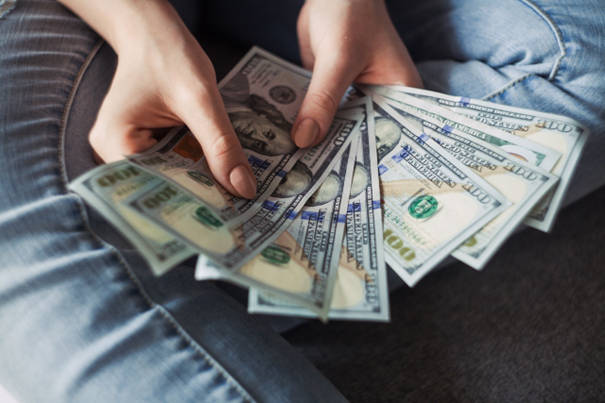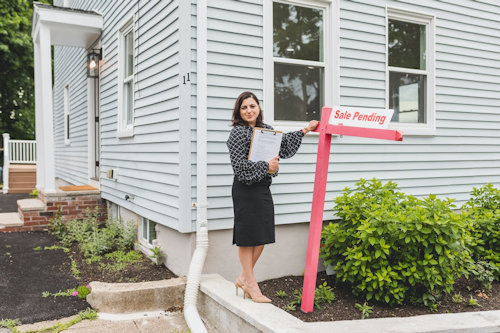Selling your home can be a stressful process. From finding the right buyer and negotiating the best deal to packing up all of your belongings, there are a lot of moving pieces. One important part of the sale process is how you will receive payment. Here are some ways you can receive payment for your home’s sale.
Cash
If your buyer has enough funds available, they may choose to pay cash for your home in full. Of course, selling for “cash” doesn’t mean the buyer walks into the office with a suitcase full of $100 bills. Buying for “cash” means that the buyer has enough money in assets i.e. bank, brokerage, etc. to pay for the house in full without getting a mortgage.

According to Investopedia, “Paying cash for a home eliminates the need to pay interest on the loan and any closing costs. There are no mortgage origination fees, appraisal fees, or other fees charged by lenders to buyers.”
Sellers often prefer a “cash sale” because they don’t have to worry about whether the buyer will qualify for the loan. There is also much less paperwork involved, so the transaction can often be closed quicker.
In this case, you’ll need to work with an escrow company or real estate attorney to help ensure that all paperwork is filed correctly and that you receive payment in full. Be sure to check with local laws and regulations about any taxes or fees associated with a cash transaction before finalizing the sale. Selling homes for cash can be a great way to have peace of mind when it comes to receiving your payment.
The only downside for a seller in a “cash sale” is that the buyer may want a “discount” in exchange for the easy transaction thus you may end up with less cash in your pocket. This is the way most “We Buy Your Home” companies work, i.e., by offering a quick cash sale for a discounted price.
Mortgage Loan
Most regular buyers use a mortgage loan as their primary method of financing for a home purchase. A mortgage involves obtaining approval from a lender, who will then provide the funds to purchase the home from you. You or your agent will need to work closely with both the buyer and their lender throughout the closing process in order to make sure everything goes smoothly.
Personal Loan
Your buyer may also decide to use personal loan funds in order to finance their purchase of your home. This type of loan typically requires less paperwork than a mortgage loan, but comes at higher interest rates and shorter terms than other types of loans. It’s important to make sure that both parties understand all terms and conditions associated with this type of financing before proceeding with any paperwork or payments related to the sale.
Home Equity Loan
Finally, some buyers may choose to use funds from a Home Equity Loan as part of their down payment on your home. This type of loan allows homeowners to borrow against the equity they’ve built up in their own homes in order fund larger purchases such as those made when buying another property or making major repairs or renovations on their existing one. As always, it’s important for both parties involved in this kind of transaction to understand all terms associated with this type of financing before signing any documents or transferring any payments related to the sale of your home.
Owner Financing
In this type of purchase, the original owner acts as the bank and takes a mortgage against their property and the buyer makes payments to the seller instead of to the bank. Owner financing is sometimes referred to as “creative financing” or “seller financing.” The advantage to the seller is that they get extra income via the interest charged and may be able to sell their property during difficult times.
Owner financing can help a buyer who is having difficulty qualifying for a bank mortgage, but it does involve more risk for the seller. According to Investopedia, “The seller might require a larger down payment than a mortgage lender would, to compensate for the risk. Down payments can range from 3% to 20% with traditional mortgage lenders, depending on the type of loan. Down payments can be 20% or more in owner-financed transactions.” Another option is for the seller to accept a higher interest rate rather than a higher downpayment.
Since the seller won’t be receiving the full amount of payment up front, they will need to satisfy any outstanding leans against the property in order for the sale to proceed. Typically, this type of sale only happens if there is little or no mortgage on the property.
No matter which method you choose for receiving payment for your home’s sale, it’s important that both parties understand all terms associated with it before proceeding any further in negotiations or paperwork processes related to purchasing it from you. With proper due diligence and communication throughout the process, you can ensure that everything goes smoothly and that everyone involved walks away satisfied at closing time!
You might also like:
- 5 Ways to Sell Your Real Estate in a Tight Market
- Documents You’ll Need When Buying Your First Home
- Approved Methods to Prepare Your Finances To Buy a Home
- What to Expect When Buying a Home
- Get The Best Deal When Buying Or Selling Your Home
- Common Mistakes to Avoid When Investing in Real Estate
- 7 Unexpected Costs Of Moving To A New Home
- Is Downsizing Right for You?
- Tips in Buying a Home for Retirement



